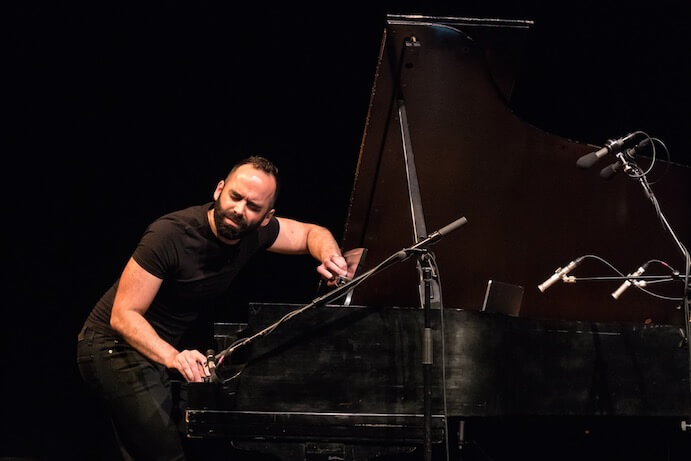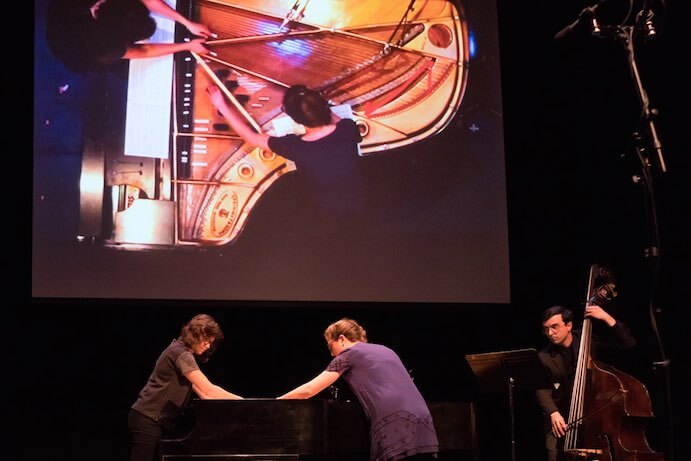Composer and performer Du Yun stated that “this program is dear to my heart” prior to a night of MATA-curated piano music on April 26, 2017. The MATA Festival artistic director and recent Pulitzer Prize winner admitted that she’s not supposed to pick favorites, but couldn’t help herself because “I grew up as a pianist—I didn’t grow up screaming.” The program, titled “88 Keys Open Many Doors,” featured works by seven different composers, including three women and one composer of color. Yun and executive director Todd Tarantino interviewed each composer about their work, drawing audience members into the compositional and performance processes without resorting to condescension. The sounds on display ranged from a consonant art song to a clangorous tone-cluster duet to the excruciatingly quiet journey of fingernails down a keyboard without depressing the keys.
The latter was performed by the virtuosic Adam Tendler, a pianist who managed to play very few actual piano notes in his two performances. In Charlie Sdraulig‘s collector (2014-2015), Tendler moved both hands horizontally from the highest notes on the keyboard to the lowest, occasionally pinching or thumping or tapping a key or two with his fingernails, and only rarely depressing a key to the point of it sounding an audible note. Tendler’s breathing was just as loud as these percussive sounds, creating the eerie sensation of an agonizing duet with himself. Towards the end of this distressing performance, as more and more notes were depressed in the lower register of the keyboard, Tendler’s hands began shaking from the physical strain.
Tendler also performed another painfully quiet non-piano piano piece with a lowercase title: Marina Poleukhina‘s exquisite for thing (2013). This piece consisted of Tendler maneuvering music boxes around different resonant and not-so-resonant areas of the piano, as well as tapping the music boxes on the piano lid, which remained closed for the duration of the piece. Poleukhina’s piece is Cage-tinged in almost every way, from the unconventional piano sounds to her program notes which read “…this is a description about the absence of description”—yet ultimately her work constructed a unique sound world all its own. It was clear from Tendler’s shaking hands and sweat-drenched shirt that both performances were extremely taxing for him; many audience members held their breath so as not to miss a single minuscule sound.

Adam Tendler performs Marina Poleukhina’s for thing–Photo by Steven Pisano
Similarly virtuosic, but about 10,000 times as loud, were the two performances of the piano duo HOCKET. Sarah Gibson and Thomas Kotcheff brought an unparalleled exuberance to their rendition of Joseph Michaels‘ Together in Perfect Harmony (2014), which mostly consisted of tone clusters bouncing up and down the keyboard. At one point both pianists, practically laughing out loud, laid their full forearms across the keyboard (shouldn’t this piece be called Fourarms?), generating such extreme hops and leaps of dissonance that it went all the way around the bend into consonance. They also performed Michael Laurello‘s Touch (2016), in which an opening section of chaotic staccato notes morphed into smoother phrases and then staggered dissonant chords built out of the opening material.
At the opposite end of the spectrum was Sojourner Hodges‘ Fire Command Room (2010), a lovely art song based on Edna St. Vincent Millay’s poem “The Blue-Flag in a Bog” and given a delightful performance by pianist Blair McMillen and soprano Sarah Brailey. Molly Herron‘s Full Blood Moon (2014/2017) was originally composed for double bass and overtone harp, but was reworked for double bass and bowed piano, here executed by the composer alongside percussionist Amy Garapic. As Herron and Garapic bowed and strummed piano strings and drummed on them with itty bitty mallets, bassist Pat Swoboda sounded notes that were plucked, slid, and bowed. As with Sdraulig’s piece, a bird’s-eye view of the piano was projected onto a screen, so that audience members could more easily observe the intricacies of the careful movements producing the sounds.

Molly Herron’s Full Blood Moon–Photo by Steven Pisano
The only work that didn’t in some way involve a piano was Karen Keyhani‘s Nightly Monologue II (2013) for harp. The Iran-based composer tinges his sound world with Persian modes and musical traditions; harpist Bridget Kibbey delivered these sounds to our ears with a stunning fluidity. After the performance Du Yun and Tarantino interviewed Keyhani via skype, who had stayed up until 3:30 in the morning Iran time to greet us and tell us about his work. Although Tarantino made only a vaguely political comment, stating that “we need to find a way to get you to New York to hear your music in person next time,” Du Yun was more explicit, stating firmly that “we will make it happen.” (Iran has been one of the countries affected by President Trump’s attempted travel bans over the past several months.) In an era in which racism and Islamophobia are becoming more prevalent and accepted in the U.S., thank goodness for figures like Du Yun, a true new music role model who advocates for composers, artists, and people from all backgrounds in her art and curating.





















